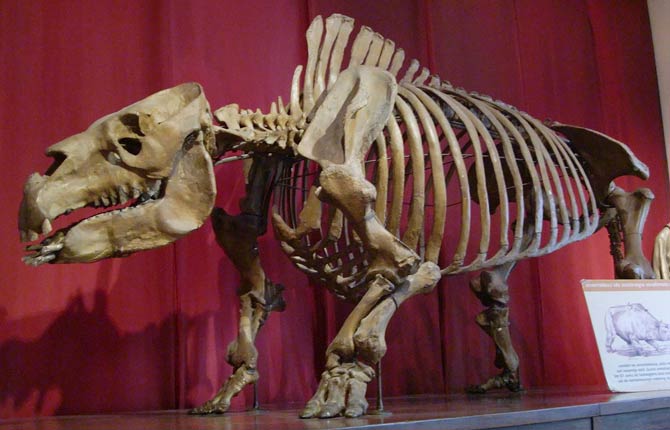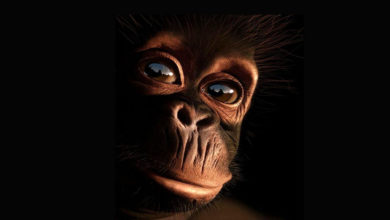Toxodon
Charles Darwin described Toxodon as “one of the strangest animals ever discovered”. What is the uniqueness of this mighty Pleistocene mammal? Certainly not one, but several features made Darwin himself impressed with the skull he had bought for 18p from a farmer. Let’s try to get to know these features and see if the English naturalist was telling the truth.
In the depths of prehistoric South America, roamed a magnificent creature unlike any other. It was large, robust, and had a unique set of physical features that set it apart from any other mammal on the continent. This animal was the Toxodon, a giant herbivore that lived during the Pleistocene era, approximately 11.6 million to 11,700 years ago.
Toxodon’s discovery was a breakthrough in the field of paleontology, as it provided a glimpse into the prehistoric past of South America, which has remained shrouded in mystery for centuries. The first fossils of Toxodon were unearthed in Uruguay in the 1830s by the famous British naturalist Charles Darwin during his historic voyage aboard the HMS Beagle.
Since its discovery, Toxodon has fascinated scientists and the public alike, as they try to piece together the puzzle of this strange and marvelous creature. Its unique features include a massive skull, heavily muscled limbs, and a broad snout with teeth adapted for grinding tough plant material. It was the largest herbivore in South America during its time, weighing up to 1,500 kg (3,300 lb) and measuring over 1.5 m (4.9 ft) tall at the shoulder.
Toxodon’s robust body and powerful legs suggest that it was a slow-moving animal that grazed on vegetation in open grasslands. Its skull and teeth, on the other hand, suggest that it had a varied diet and could eat tough, fibrous plants as well as softer leaves and fruits. It is believed that Toxodon was a key part of the ecosystem, serving as a food source for predators such as saber-toothed cats and giant birds.
Despite its impressive size and unique features, Toxodon disappeared from the fossil record at the end of the Pleistocene era. The reasons for its extinction remain a mystery, but it is likely that a combination of climate change, habitat loss, and competition with other herbivores played a role.
Despite its extinction, Toxodon’s legacy lives on in the scientific community, as it continues to inspire research and discovery. Its discovery and study have shed light on the rich history of South America’s prehistoric fauna and provided insights into the ecological relationships between species during a time of great change.
As we continue to explore and learn about the natural world, Toxodon stands as a testament to the awe-inspiring diversity and complexity of life on our planet, both past and present.

Classification
- Kingdom: Animalia
- Phylum: Chordata
- Class: Mammalia
- Order: †Notoungulata
- Family: †Toxodontidae
- Subfamily: †Toxodontinae
- Genus: †Toxodon
- Species:
- †Toxodon platensis
- †Toxodon burmeisteri
- †Toxodon chapalmalensis
- †Toxodon darwini
- †Toxodon ensenadensis
- †Toxodon expansidens
- †Toxodon gracilis
Dating and occurrence
It is estimated that this large mammal lived on our planet from about 3 million (11.6 million?) to 11 thousand years ago, that is, from the Late Miocene to Holocene.
Its remains were discovered in South America, incl. in Argentina and Uruguay. Charles Darwin wrote about it, who incidentally was one of the first discoverers of Toxodon fossils.

Anatomy
Toxodon was similar in size and proportion to modern rhinoceros, but in the past, it was thought to have features of hippos and even elephants.
The skull found is massive, suggesting that the Toxodons were very heavy animals. The arrangement of the bones of the feet also suggests that they had short stout legs with plantigrade feet – this way of walking (on the whole feet, not only on the toes) may confirm the thesis that the animal was heavy (although on the other hand, elephants do not mind it – they walk on their toes :)).
A broad, squat body suggests that the digestive system was very extensive, similar to today’s large herbivores. The hind limbs were longer than the front limbs, so the silhouette tilted forward. This would mean that the head was close to the ground from which the mammal could easily pick up plant food.
The protrusions on the anterior dorsal vertebrae were probably enlarged so that the neck muscles supporting the heavy skull could attach to them. It is possible, however, that on the back, instead of the muscles, there was a hump that acted as an energy store in times of crop failure.

An aquatic animal?
Many reconstructions of Toxodon present it as a semi-aquatic animal, similar to hippos. A large, heavy animal, immersed in water, moved more easily and obtained food more efficiently, e.g. aquatic plants. From the twentieth century, however, gradually began to depart from this theory.
The main reason for this is the fact that during the reign of Toxodons in South America, the climate was very dry, creating steppes and grassy savannas. In addition, an animal with a head as low as Toxodon, would have a hard time keeping it above the surface of the water.
Diet
The width of the mouth indicated that the animal has been able to maintain a diverse plant diet that included grasses, leaves, shrubs and low trees. So far, however, these are only assumptions. Scientists speculate that Toxodon may have had prehensile lips. If this were true, Toxodon would be able to adapt to a variety of environmental conditions. It would eat whatever was currently available.

Extinction
Toxodons may have been one of South America’s most widespread herbivores. However, they lived in times of major changes, because during the formation of the Panama Isthmus (not to be confused with the Panama Canal ;)), which today connects North and South America. This process has made it possible for previously isolated species to travel to other continents.
It is unlikely that Toxodons would fall victim to large flightless birds of the Phorusrhacidae family, as these dangerous birds had already died out before the appearance of Toxodons. However, this extinction could have had a lot to do with North American predators that crossed the land bridge and entered South America. One of these dangerous predators was certainly the smilodons. It is possible that the saber-toothed tigers that came to South America, with time specialized in killing large Toxodons.
Man had a significant influence on the extinction of the Toxodon genus. Arrowheads have been found along with Toxodon bones, which may indicate that the people who came to those lands hunted for them fiercely. Certainly, however, the increased hunting by the first humans was not the main cause of the genus extinction. It is suspected that, like the rest of the representatives of the Pleistocene megafauna, Toxodons disappeared from the surface of the Earth due to climate change, diseases, and perhaps as a result of a comet impact.

Detailed data / dimensions (size)
Toxodon
- Body length: 2.7 m (8.9 ft)
- Height at the withers: 1.5 m (4.9 ft)
- Potential weight: 1,500 kg (3,300 lb)
- Temporal range: (11.6 million?) 3 million – 11 thousand years ago (Late Miocene-Holocene)
- Distribution: South America, Uruguay and Argentina

Toxodon – interesting facts
- The name Toxodon means “bow tooth”. It refers to strongly curved upper incisors, which interested Richard Owen – the creator of the description of Toxodon.
- Toxodon, like rhinos today, could gallop while escaping from attackers. It is possible that he also deterred enemies in this way. It, therefore, seems that its greatest weapon against predators was its large size.
- The man who found the first bones of Toxodon, including the skull, was Charles Darwin. The 22-year-old scientist was then on a 5-year journey on the HMS Beagle.
- Darwin acquired the Toxodon skull not by excavation, but … by a commercial transaction. The scientist bought it from an Uruguayan farmer for 18p and then sent it to Richard Owen, who analyzed the find.



















